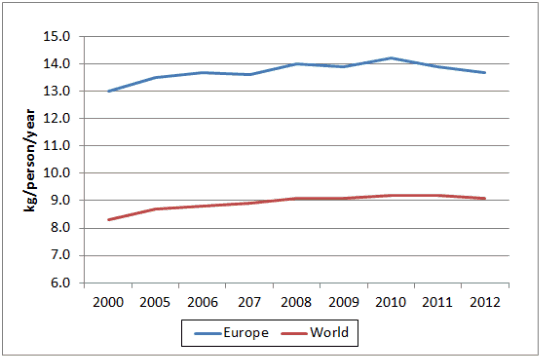



GLOBAL POULTRY TRENDS 2011 - Slow Population Growth but Rise in Processed Egg Uptake in Europe
With the population likely to remain fairly constant, the key feature of the egg market in Europe in the coming years is the rise in the consumption of egg products by the region’s residents, according to Terry Evans in the last part of his analysis of the European egg industry. Some estimates point to the proportion reaching as high as 40 per cent in certain countries by 2025.By 2015, the population of Europe will have increased by a mere 15 million compared to 2000. However, while the number of people within the EU is expected to increase from 482 million to almost 507 million, the total living elsewhere in Europe is forecast to decline from 245 million to nearly 235 million. While amendments have been made to the human population estimates (table 1) the FAO has not updated its consumption data.
Previously in these regional reports, it has been explained that the consumption figures per person – either in weight or numbers of eggs – are the most unreliable of all the industry statistics. From the data in table 1, it would appear that that average egg consumption in Europe is about 50 per cent above the global figure and also that, unlike the other regions reviewed in this series, there is far less variation in the uptake levels between countries.
While consumption per person in the European Union seems to have declined a little, outside the Community, it has increased quite considerably such that while, prior to 2003, the European average was below that for the EU, since then it has been above it.
Currently, world average egg consumption looks to be a little above 9kg per person, which would point to the European figure being around 13.7kg in 2012 (Figure 1).
Data published by the International Egg Commission (IEC) on egg consumption gives a mixed picture with the uptake per person in 2010 falling in some countries but rising in others. At first sight, it appears that movements between years simply reflect changes in available supplies which, in turn, are the result of actual or likely future changes in the levels of profitability of egg production. Without the corresponding price data it is not possible to assess whether the demand for eggs has altered.

However, one feature which appears to be common among most IEC member countries is that the consumption of eggs in egg products is on the increase. In 2010, egg products, as shell egg equivalent, was highest in Italy with the average at 75 eggs per person, which represented 36 per cent of a total annual consumption of 210 eggs per person. Belgium came a close second with a products uptake of 74 eggs per person but, in this case, the products represented 44 per cent of a total consumption of 170 eggs.
Certainly, it is the products sector of the market that will offer the greatest opportunity of an expansion in egg use in the foreseeable future, with some estimates pointing to the figure reaching as high as 35 to 40 per cent of production by 2025, depending on country.
April 2012









